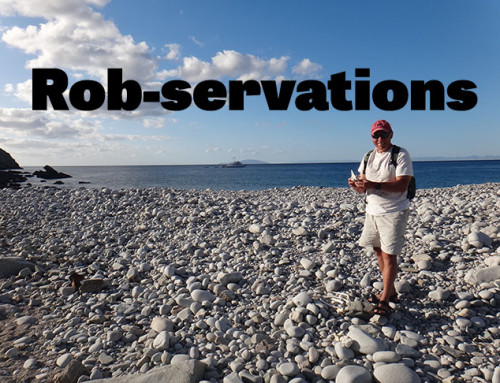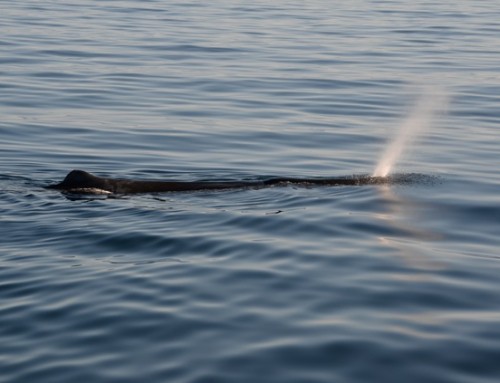The harbor seal (Phoca vitulina) is one of four species of pinnipeds regularly found in the waters around Baja California (for a discussion of pinnipeds in general, please see my Rob-servations Blog #10). Harbor seals are members of the pinniped family Phocidae, as is the northern elephant seal, another Baja pinniped species. All members of this family share various traits that help distinguish them from the other major group of pinnipeds, the family Otariidae (which includes the California sea lion and Guadalupe fur seal, also found in Baja. See photos below for comparison).

Guadalupe fur seal

California sea lions
Harbor seals (and other phocids) lack an external ear flap, have relatively small front flippers (compared to otariids), cannot rotate their hind flippers forward, hunch along awkwardly when on land, and primarily use their hind flippers and bodies when swimming underwater (see Blog #10 for more details).
As a general rule, phocids tend to have little to no sexual dimorphism, while otariids are characterized by having sexual dimorphism. The term “sexual dimorphism” refers to the differences between male and female members of a species. Many people equate the term with differences in body size, but the term also encompasses other differences, such as the bright colors in some male birds, or the antlers in male deer. Harbor seals fit the typical model for phocids, in that male and female harbor seals are generally indistinguishable by size. (The BIG exception to the lack of sexual dimorphism in phocids is the elephant seal.) When examining dead harbor seals on the beach, I can tell male from female by the relative positions of the genital aperture and anus. When viewing live harbor seals in the wild, however, we rarely get that close a look and consequently cannot distinguish male from female. Harbor seals in the Pacific Ocean can sometimes get a bit larger than six feet (1.82 meters) but are usually less than 300 pounds (136 kilograms) in weight.
Harbor seals are the most widely distributed of all 33 pinniped species. They inhabit both the North Atlantic and North Pacific oceans, and are typically found along both coasts of North America, northeastern Asia, and northern Europe (including the United Kingdom). Ironically, of the four species of pinniped seen on our Baja trips, the harbor seal is among the least likely to be seen. The reason for this is that the Baja peninsula is the southernmost range limit of eastern Pacific harbor seals. Much of our tour takes us south of and beyond the range of harbor seals.
The best chance to see harbor seals during our Searcher Natural History Tours is during the first two full days of the trip. On the morning of the first full day, after clearing Customs in Ensenada, Mexico, we sail past a group of islands called Todos Santos. From the Searcher, we can see many species of birds, as well as any pinnipeds associated with the islands. We sometimes see harbor seals hauled out on the beach or bobbing in the water.
The second full day of the trip is spent at the San Benito Islands, specifically at West San Benito Island. We sometimes see harbor seals here. However, because the San Benito Islands are close to the southern limit of eastern Pacific harbor seals, we see harbor seals here less frequently than we do at the Todos Santos islands. Once we depart the San Benito Islands and continue even further south, we almost never see harbor seals again. The southernmost haul-out site for eastern Pacific harbor seals along the Baja peninsula is San Roque Island, about 110 miles (176 km) southeast of the San Benito Islands. However, our cruise track does not take us close to this island.
Much of the haul-out behavior of harbor seals in Baja is related to the annual molt, in which old hair is shed. Loss of body heat is high during the molt, so seals mitigate some of this heat loss by hauling out on land, rather than remaining in water (the rate of heat loss is greater in water). The annual molt cycle is triggered by photoperiod. Thus, seals at more southerly locations start molting first, and the timing of molting then progresses northward. For example, molting occurs at San Roque Island from February to June, while molting occurs at Todos Santos Island from April to July. Because seals are more likely to be hauled out while molting, researchers use the peak of the molting season to conduct population census counts of seal numbers. Harbor seals also haul out for pupping and nursing. Pupping season provides another opportunity for researchers to make population counts. Most pupping by harbor seals in Baja occurs in February and March.
All four species of Baja pinnipeds were subject to commercial exploitation during the 19th century and the first half of the 20th century. Now, with the cessation of hunting, and with legal protections, these species, including the harbor seal, are recovering in numbers and are repopulating their historical range. Although harbor seals may not be a “target species” for many eco-tourists to Baja, it’s always wonderful to see them, especially considering their recovery from exploitation.
–Rob Nawojchik, marine biologist and Searcher naturalist





